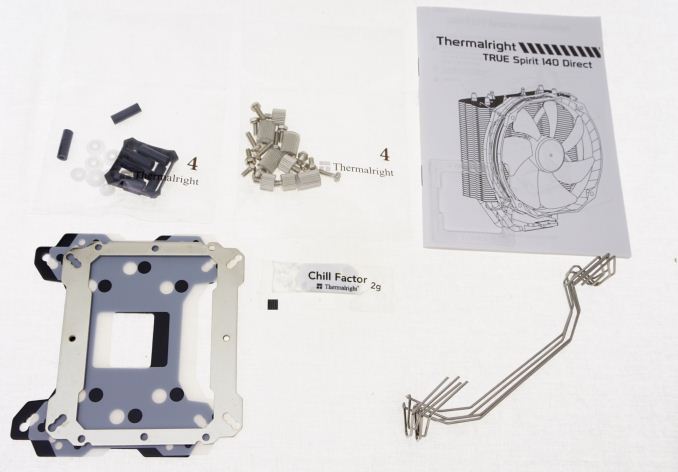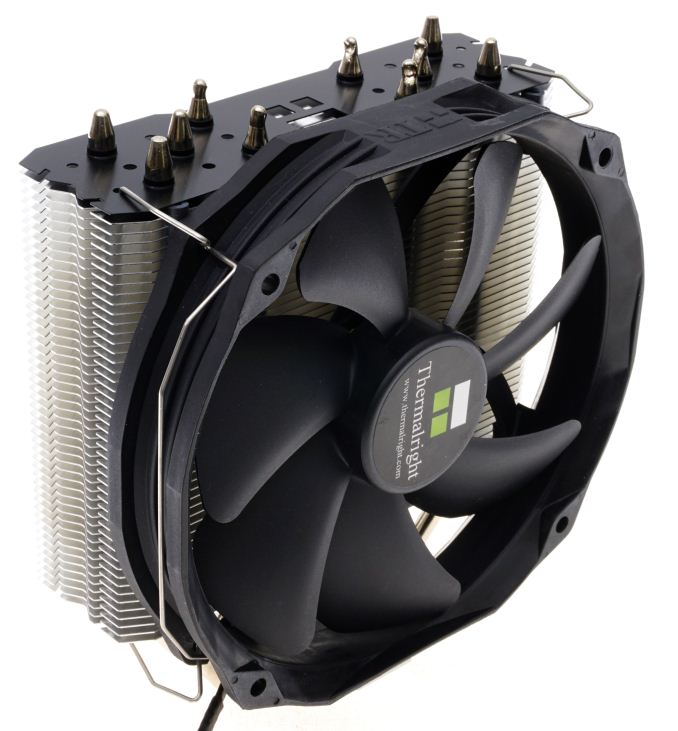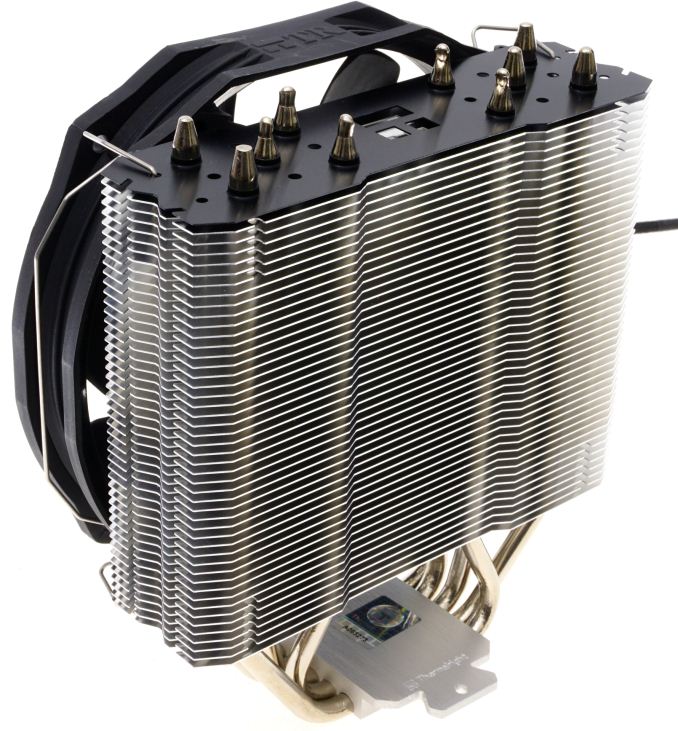The 140mm Slim Tower CPU Cooler Roundup: Thin & Light Done Just Right
by E. Fylladitakis on May 24, 2017 8:00 AM EST- Posted in
- Cases/Cooling/PSUs
- be quiet!
- Noctua
- Phanteks
- Cooler
- Thermalright
Thermalright True Spirit 140 Direct
Thermalright is practically a newcomer here in AnandTech, as we have not looked at any of their products since 2010 and our last Thermalright CPU cooler review is now nearly a decade old. The cooler that we will be reviewing today is the Thermalright True Spirit 140 Direct, the upgraded version of their popular Thermalright True Spirit 140 cooler. It comes supplied inside a dark box with minimal artwork, only a clear picture of the cooler itself and icon denoting its most important features.
Inside the box we only found the absolute necessary parts for the installation of the cooler, which are a one-fits-all backplate, mounting hardware, fan support wires, fan anti-vibration standoffs, and a small but detailed installation manual. Thermalright also supplies one dose of their “Chill Factor” thermal compound.
Much like Noctua’s and Be Quiet!’s offerings, the Thermalright True Spirit 140 Direct has a single 52 mm deep fin array with a 140 mm fan attached on it. The fin array is relatively simple, with only a recessed center area to reduce the aerodynamic drag noise. The top fin of the array has been painted black for aesthetic purposes. It has five 6 mm nickel-plated heatpipes.
Thermalright is using one of their TY-140 cooling fans on the True Spirit 140 Direct. The TY-140 is a PWM general purpose cooling fan that has been initially designed with 120 mm mounting holes to maximize compatibility. The company advertises its “Enhanced Hyper-Flow Bearing (EHFB)” engine as consistent and highly reliable, without any further information regarding its design and/or mechanics.
The fan mounting mechanism is strange, with the fan having to sit on rubber standoffs that need to be inserted into small cutouts on the fin array. It is not possible to mount the fan without these standoffs. Hopefully the rubber that they are made of will last for several years, but replacements may be necessary for people who keep their hardware for more than a few years or if they are lost. (Tip: Pieces of large drinking straws do work as a temporary solution)
The large difference between this cooler than the others in this roundup review (and also its major upgrade over the previous version) is the design of its base. Instead of having a contact plate coming in contact with the CPU and the heatpipes attached to it, the heatpipes of the True Spirit 140 Direct are in direct contact with the CPU itself. The top part of the base is made of machined aluminum and only provides mechanical cohesion and retention bracket support.
















74 Comments
View All Comments
Samus - Wednesday, May 24, 2017 - link
I think the thermalright cooler is pretty hard to ignore unless you are running a high-wattage CPU. Mild overclocks of a typical 80w CPU will make the thermalright the ideal solution at ~100w load, and also the quietest.Communism - Wednesday, May 24, 2017 - link
The problem with E. Fylladitakis 's style of testing is that they miss major factors in how the things tested actually function in relation to what they are made for.The reason why Noctua always does "better" in these synthetic tests is that they generally have a 100% flat contact surface.
The problem with 100% flat contact surfaces is that CPU IHS aren't anywhere close to 100% flat surfaces.
Most CPU IHS are concave, which is why Thermalright HSF always have convex contact surfaces.
Clamping pressure is also highly important, especially for Intel's non-soldered IHS CPUs.
Higher Clamping pressure both reduces the distance between the silicon and the IHS as well as forms a better mating between the IHS and the convex Thermalright contact surfaces.
These, and many other major factors that crop up in the real world make the 100% artificial testing like E. Fylladitakis conducts in actually have an extremely large margin of error, making them far less useful than the testing "scienciness" would lead you to believe.
fanofanand - Thursday, May 25, 2017 - link
If what you are suggesting is true, we should see Thermalright outperforming Noctua in every other publication's testing, correct? Most review sites (I believe all other sites actually) test CPU cooler performance on an actual CPU running tests, and more often than not inside of an actual computer case. Yet those same tests bring very similar results to what Anandtech has shown, which would appear to invalidate your entire postulation. How do you explain the lack of disparity between these other journalists' "real world" cases, and what Anandtech has done?Communism - Thursday, May 25, 2017 - link
Keep up your rhetorical questions.I don't know why I bother posting on this shill infested site anyways, waste of my time.
I'm not going to spoon-feed you for 20 posts like the forums.
I've spoonfed you for literally 100 posts before on the forums and your shill self has never acknowledged anything, making this a pointless conversation by any metric.
Have fun shilling with the other shills, adequate journalism in technology died quite a long time ago, and it shows.
Zetbo - Friday, May 26, 2017 - link
What a loser you are. When the data does not backup your point of view...you call everyone a shill! Thats the way to go! :DCommunism - Friday, May 26, 2017 - link
Took you a whole day to make another account?You really should get your pay docked.
Keep going and you're getting doxed.
fanofanand - Friday, May 26, 2017 - link
Doxx me big boy :)fanofanand - Friday, May 26, 2017 - link
Uh, I'm not on the forums, have you been taking mushrooms? I did read that they are the "least dangerous" psychadelics, but you seem to have overindulged. Apparently my point was irrefutable as you chose not to refute anything I wrote.BrokenCrayons - Friday, May 26, 2017 - link
The testing methods used in these HSF reviews are perfectly adequate because they remove a number of uncontrollable variables that would result from testing with PC hardware. The simulator equipment can produce repetable results with little to no variance between tests within AT's limited budget. I much prefer artifical tests as the basis for relative comparisons since the tests performed by other review sites won't accurately emulate my specific computing environment anyway and are therefore only useful as similarly relative comparisons. The science of these results appear trustworthy.WinterCharm - Thursday, May 25, 2017 - link
Funny how Thermalright performed better than Noctua at low and high fan speeds, then!